It’s a tough decision but how great is it to have two fabulous archaeological sites within striking distance of Rome? I have visited both places and think that Ostia Antica trumps Pompeii (although it’s a close-run thing).
If you are a history fangirl or fanboy, you will relish the opportunity to learn more about Ancient Rome in the absence of the crowds that descend on Pompeii. But even if history isn’t your thing, Ostia Antica is a wonderful retreat from the hustle and bustle of Rome.
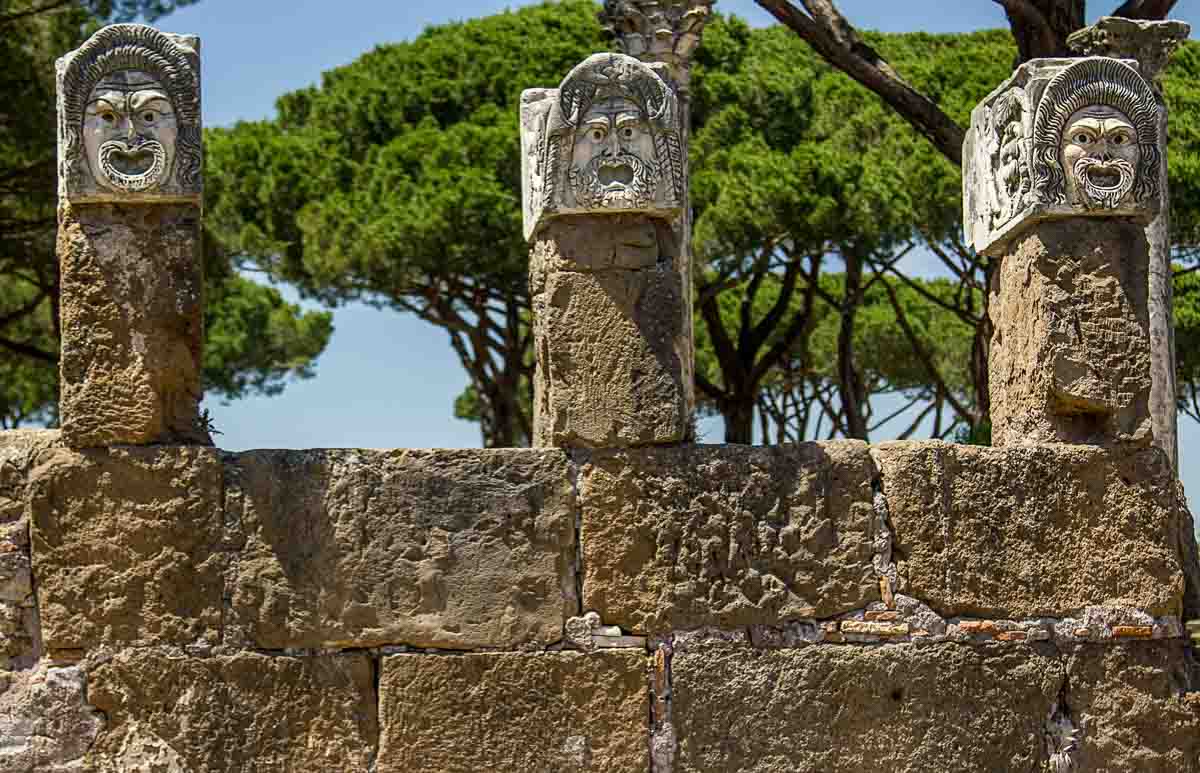
Some articles on this website contain affiliate links. This means that I may earn a small commission if you make a purchase through these links. As an Amazon Associate, I earn from qualifying purchases. Read the full disclosure here.
Introducing Ostia Antica
Ostia was the harbour city of ancient Rome and is famous for its well-preserved mosaics, frescoes and ruins. Walking around this archaeological park offers a window into life in a busy Roman town 2,000 years ago.
It was a working port town, populated by a spectrum of social classes. Although Ostia Antica was ruled by a small number of aristocratic families, immigration and the import of slaves swelled the town’s population. Once freed, slaves often remained active in the trade of their former patron.
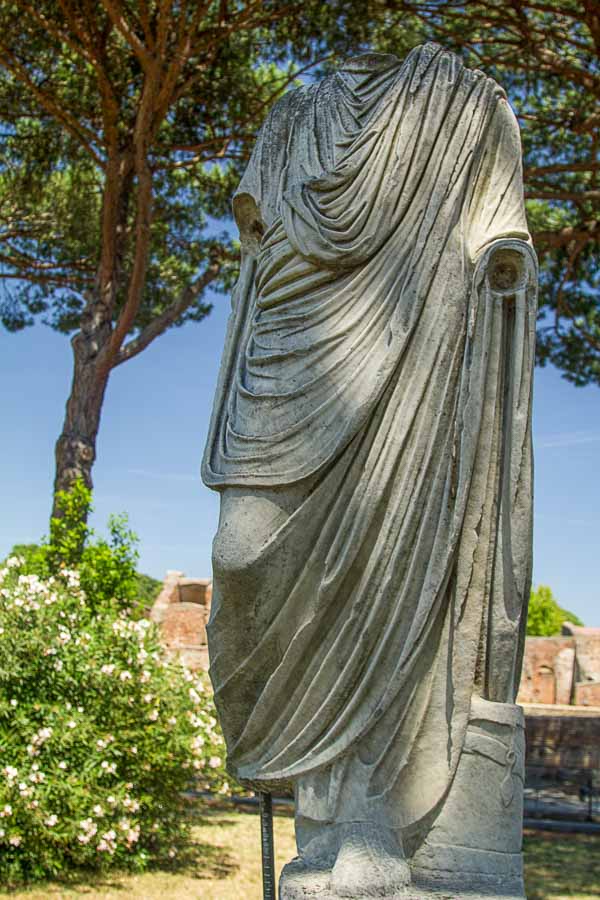
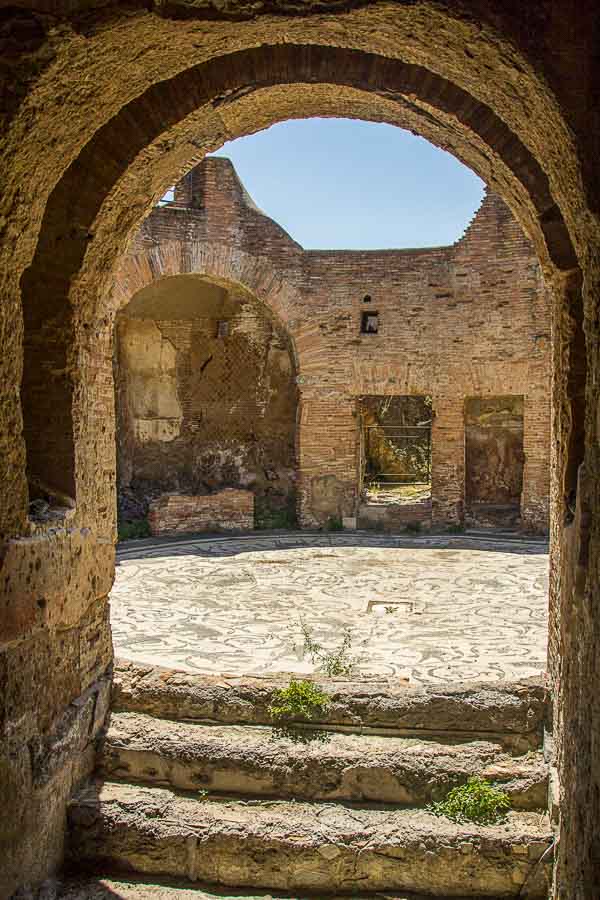
Why you should visit Ostia Antica
It has huge historical significance
Why was Ostia Antica important to the city of Rome? Even in Ancient Roman times, it was location, location, location.
According to legend, Ostia was founded by Ancus Marcius, the fourth king of Rome, as a castrum (military fortification) to guard the mouth of the Tiber. In the 3rd Century AD, the city developed into the port of Rome and was the gateway for Rome’s exports and imports, notably the grain supply to the capital.
The town was named after its location, Ostia meaning “mouth” in Latin. Over the millennia the shoreline has moved seaward, due to the silting of the Tiber, and Ostia Antica now lies three kilometres from the sea.
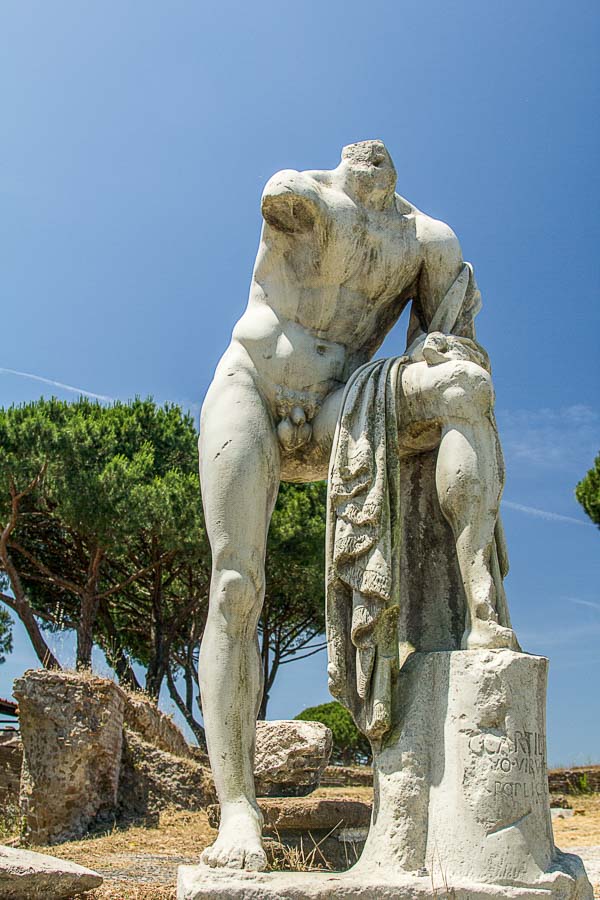
Ostia Antica lacks the crowds of Rome or Pompeii
I love Rome on so many levels and have lost count of the number of times I have visited. But at any time of the year, it is extremely busy, sometimes overwhelmingly so.
Ostia Antica is a perfect refuge from the city’s crowds, traffic horns and selfie stick-wielding tourists. When I visited, I shared the site with only a handful of other visitors.
At times, Pompeii feels like an Ancient Roman Disneyland. There are extremely good reasons why it is popular, but this is of little comfort when you are trying to navigate around coachloads of tour groups.
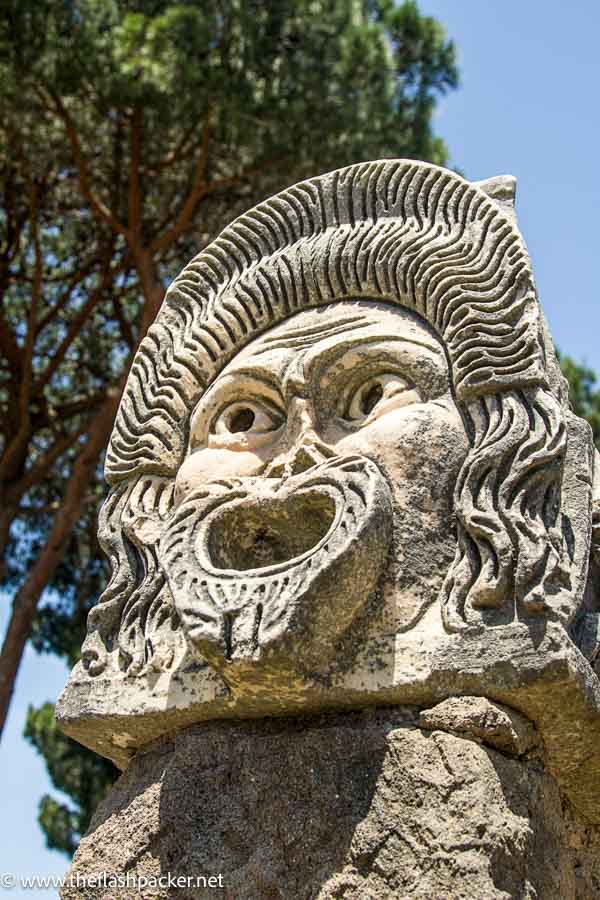
Getting to Ostia Antica from Rome is super easy
Pompeii is a LONG day trip from Rome.
Consider this. It will take you at least 2 – 3 hours to travel from Rome to Pompeii, involving a change of train at Naples. After this journey, you need to do the massive site of Pompeii justice before jumping back on your return train to Rome.
I know that many people visit Pompeii as a day trip from Rome. But not me (I visited from Naples on my last visit).
By comparison, getting to Ostia Antica from Rome is a breeze with frequent connections from the city centre. Depending on your starting point, the journey time is approximately 30 – 45 minutes.
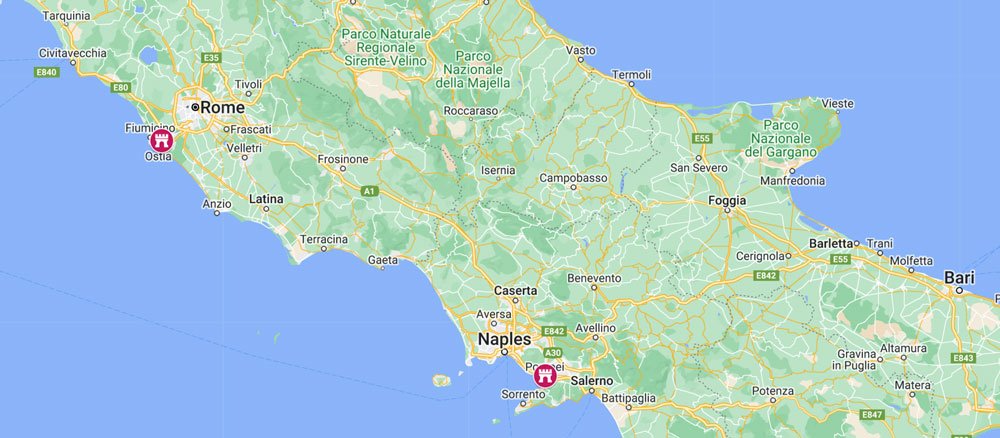
Ostia Antica is an inexpensive day trip from Rome
Let’s do the maths.
Your one-way metro ticket from central Rome to Ostia Antica will cost you €1.50 (2024 price). An entrance ticket for Ostia Antica costs €18.
Therefore, a day trip to Ostia Antica from Rome will set you back €21.
In contrast, when booked in advance, a one-way ticket for the faster trains between Rome and Pompeii will cost at least €30. As Trenitalia has dynamic pricing, you are looking at significantly more expensive fares if you book near the day of travel. You will need to plan ahead.
In 2024, an entrance ticket for Pompeii costs €22.
This brings the minimum cost of a day trip from Rome to Pompeii to over €80. Not so cheap.
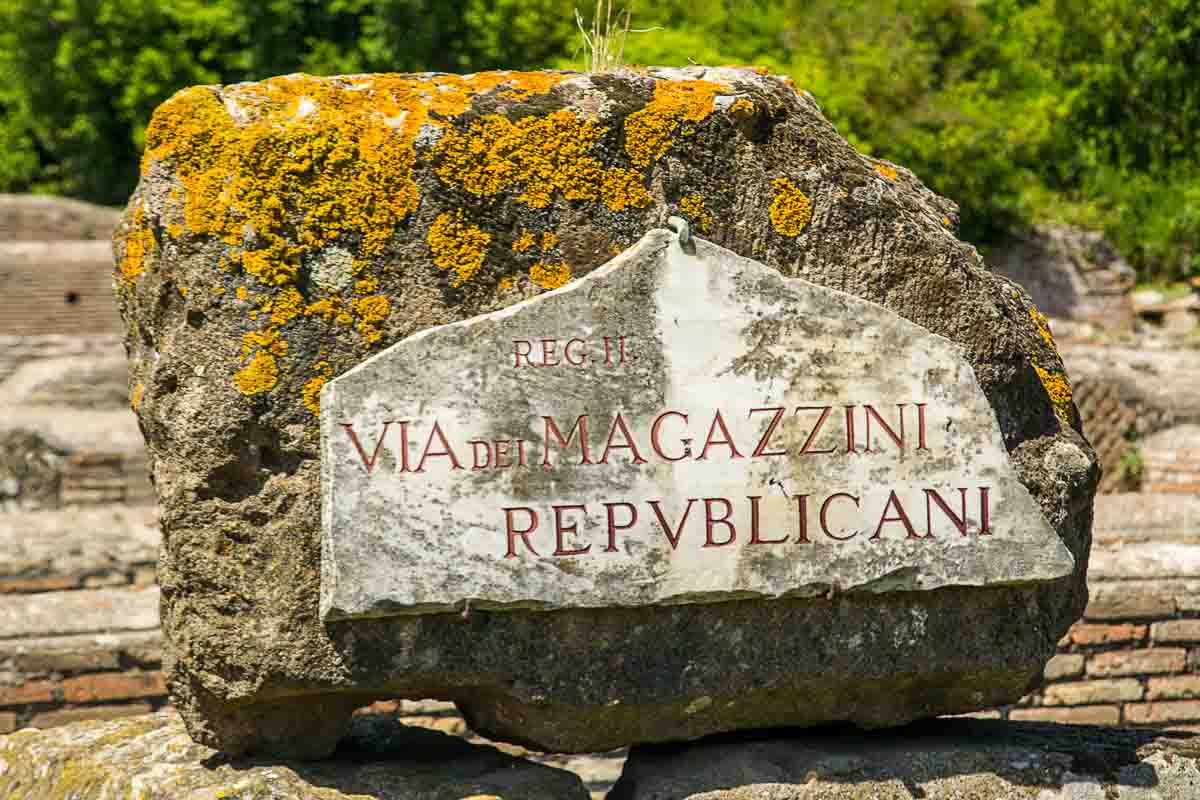
Scavi di Ostia Antica are wonderfully preserved
I’m not suggesting that this isn’t the case with Pompeii. Volcanic lava took care of that.
But if you are looking for first-class archaeology that represents everyday life, Ostia Antica is Pompeii’s equal.
Most of what we see in Ostia Antica today dates from the 3rd century BC. The excavated structures – houses, apartments, temples, bars, public baths, workshops, stores and latrines – are a window into what life was like in a commercial town at the zenith of the Roman Empire.
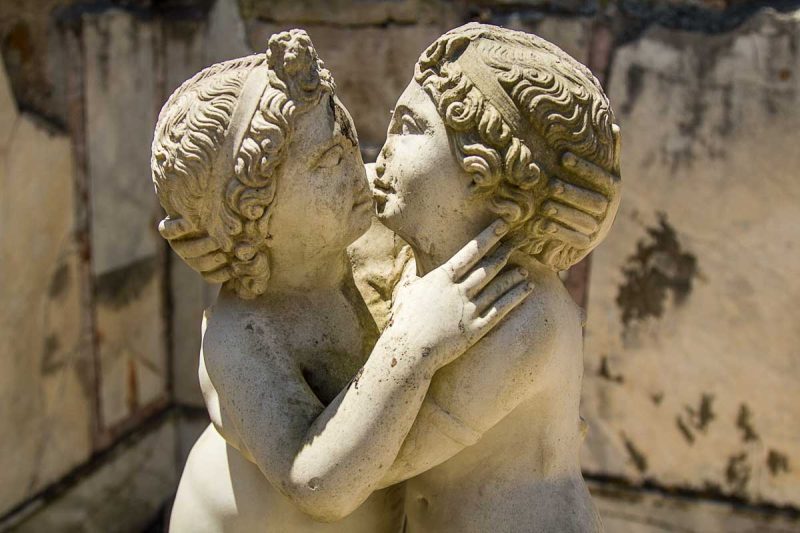
This archaeological park has superb mosaics
Mosaics were a common feature of both private homes and public buildings in Roman cities. Ostia Antica is home to a wonderful collection of floor mosaics, which are mostly black and white.
These mosaics were inspired by nature (flowers, marine animals, seahorses), gods and mythological creatures, ships and fishing. Some of the most famous mosaics at Ostia decorate the Baths of Neptune.
The highlights of Ostia Antica
Decumanus Maximus
Immediately upon entering the site, you will find yourself on the Decumanus Maximus, Ostia’s main street. Some of the town’s most important buildings flank this street.
Baths of Neptune
The Baths of Neptune, built between 117 and 161 AD, are one of the first buildings you come across walking along the Decumanus Maximus. One of the biggest excavations in Ostia Antica, these baths have several rooms and a palestra (exercise area).
Climb the steps for a great view of the massive black-and-white mosaic, depicting the god Neptune riding four horses through the sea.
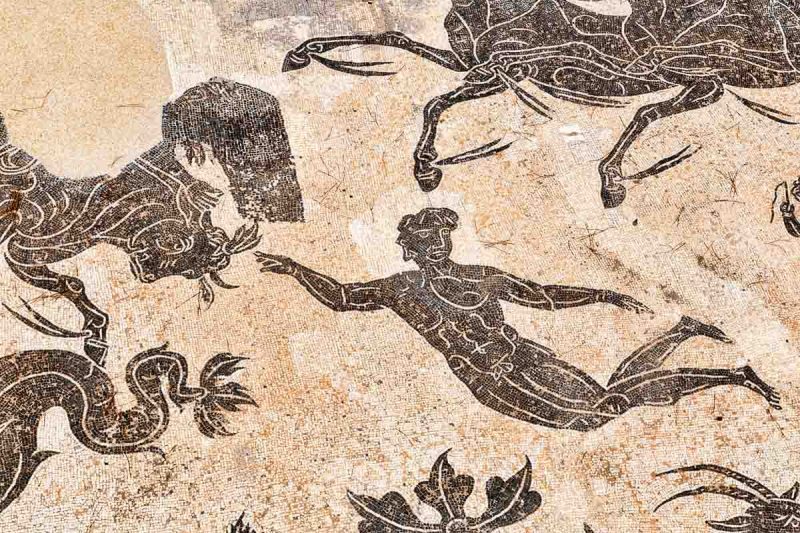
The Theatre
The adjacent Theatre of Ostia is far from understated.
Built in the 1st Century BC by Agrippa, and later expanded by Commodus and Septimius Severus, this theatre could host up to 4,000 spectators. Not unlike today, the best seats were close to the action; the cheap seats up in the gods.
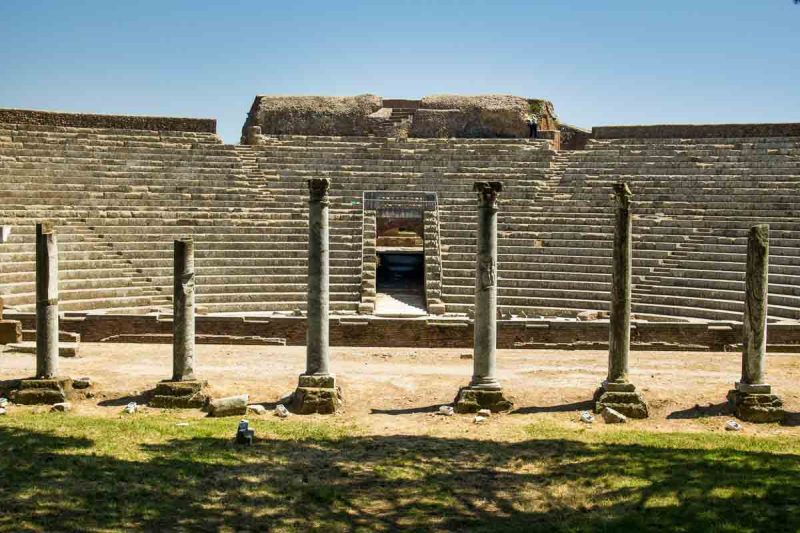
Most of the original seating area is intact as is the orchestra’s marble floor.
Climb to the higher levels for a great view of both the theatre and the town.
Forum and Capitolium
At the crossroads of the Decumanus and Cardo is the Forum, Ostia’s administrative centre.
In Ancient Rome, important buildings were clustered around the Forum. Ostia was no different and the Capitolium, the temple dedicated to the three main Roman gods – Jupiter, Juno and Minerva – still stands.
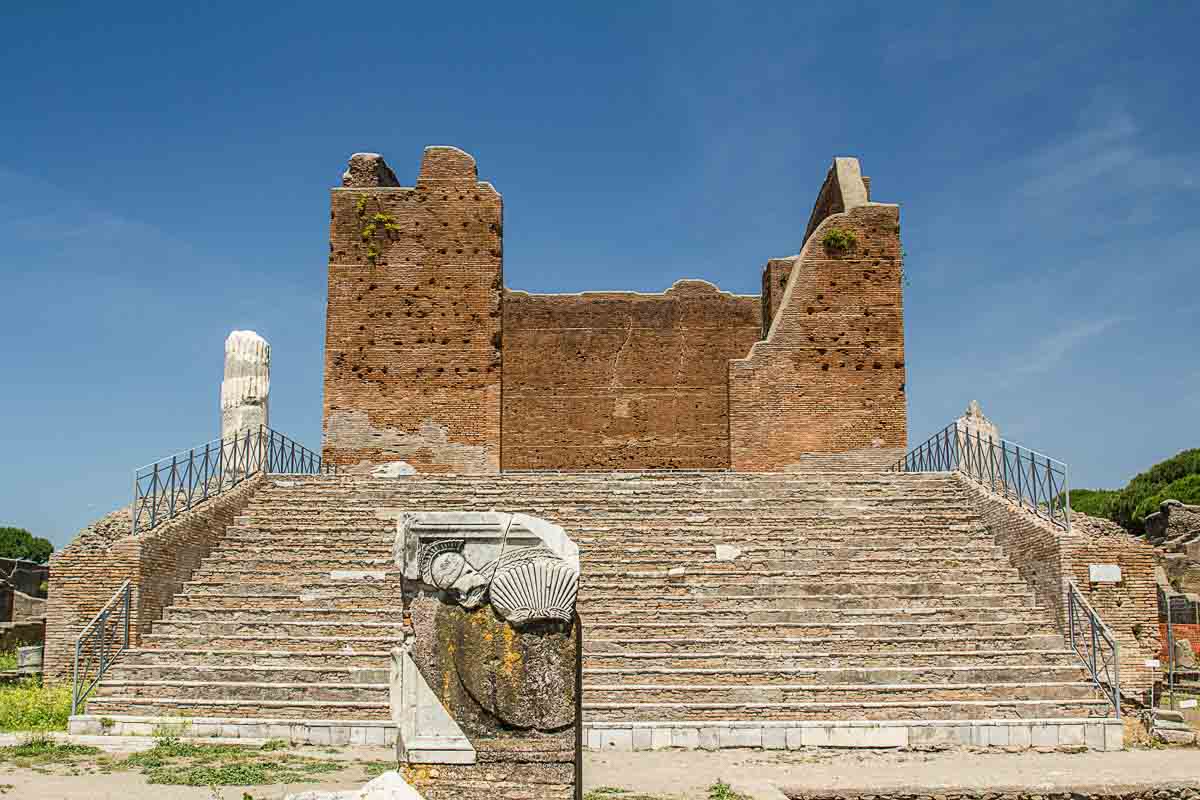
Baths of the Forum
On the eastern side of the Forum are the 2nd Century Baths of the Forum, one of the largest baths in Ostia. Off the north side of the baths is the town’s forica, the public latrine, with its 20 perfectly preserved marble seats.
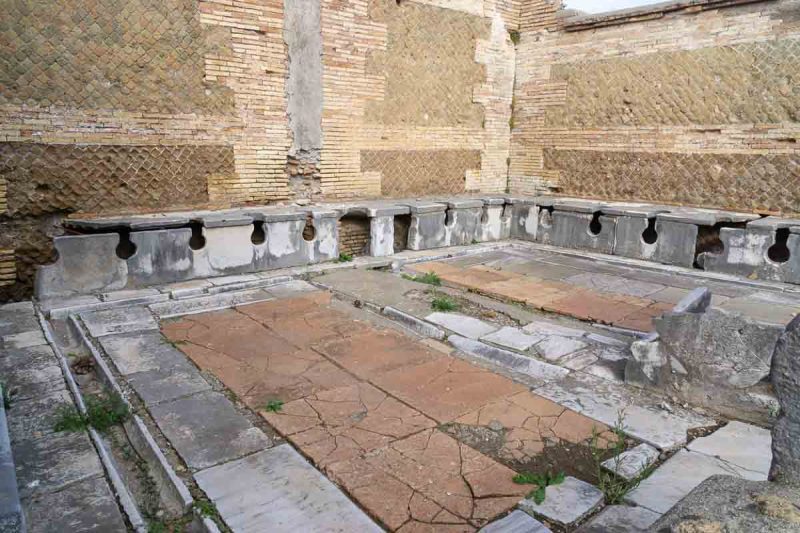
Fishmongers’ shops
The Decumanus Maximus was home to the central market for fish, meat and vegetables. The shops of the fishmonger have a marble table, a fish basin and a black-and-white mosaic with marine motifs.
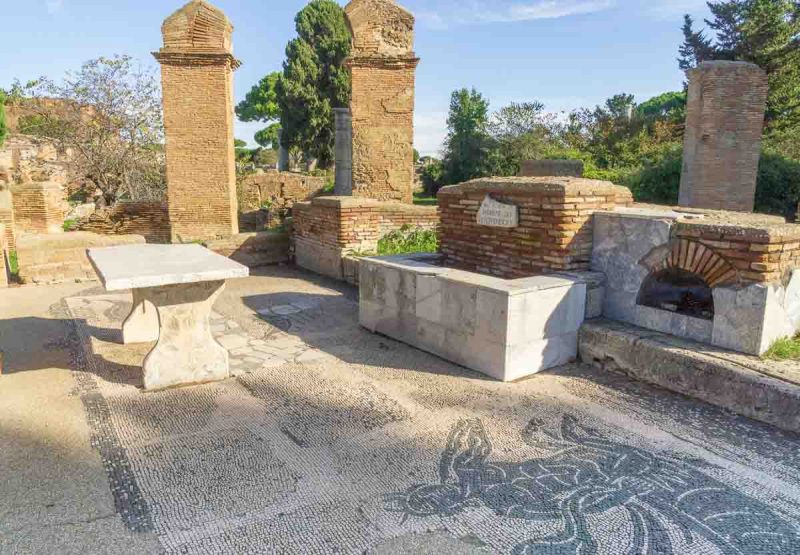
How to Get to Ostia Antica from Rome
Getting the train from Rome to Ostia Antica
From Rome, take Metro line B to Piramide stop (direction Laurentina). From Piramide, it’s a one-minute walk to Roma Porta San Paolo train station.
Alternatively, you can change trains at EUR Magliana
Transfer to the Rome-Lido (Metromare) line towards Cristoforo Colombo. Get off at the stop for Ostia Antica (30 minutes).
A normal metro ticket will cover you for the entire journey. This should take just over an hour.
On leaving the station take the footbridge that crosses the motorway running between the station and the archaeological site.
Visiting Ostia Antica on a guided day trip from Rome
However, if you feel more comfortable visiting Ostia Antica on an organised tour, or want to learn more about the site from a professional guide, why not join one of these day trips from Rome with free cancellation?
Ostia Half-Day Tour from Rome by Train
This 4-hour tour of Ostia Antica includes your transfer by train from Rome and a tour guide.
>>> CLICK HERE FOR CURRENT PRICES
Ostia Antica Guided Tour
Make the most of your day trip to Ostia Antica from Rome by joining this 3-hour private tour with an archaeologist guide. The reviews are glowing.
>>> CLICK HERE FOR CURRENT PRICES
Opening hours & ticket price
Ostia Antica is open Tuesday – Friday from 8:30 am; closing time depends on the season and ranges between 4:30 pm to 7:00 pm. Check the opening hours here.
Tickets for Ostia Antica cost €18 (2024 price). You can buy them at the small ticket office by the entrance to the archaeological site or online.
Entry to Ostia Antica is free for those under the age of 18 and the entry price is reduced to €2 for EU citizens between 18 and 25 years old.
My top tips for visiting Ostia Antica
- Allow at least two hours, preferably half a day, to explore Ostia Antica. I spent half a day there which felt like the right length of time for me.
- Make an early start to give yourself enough time to explore Ostia Antica. In summer, arriving early will also allow you to start sightseeing at a cooler time of day.
- As with many archaeological sites, there is little shade and it can get hot. Wear a hat and sunglasses, slather on sunscreen and bring a big bottle of water with you.
- Due to uneven surfaces, a comfortable pair of shoes is essential.
- Photography is allowed (but no flash).
- Buy an audioguide at the entrance or bring a good guidebook. This is necessary as, except for the major buildings, many of the structures at Ostia Antica are unmarked. I used the Blue Guide: Rome which has an excellent section on Ostia Antica
- Although there is a small restaurant near the museum, the food is not cheap. I recommend bringing a packed lunch.
- There are no luggage storage facilities at Ostia Antica. Bring only what you can comfortably carry and leave your large bags at your hotel (or use the storage facility at Rome Termini Station).
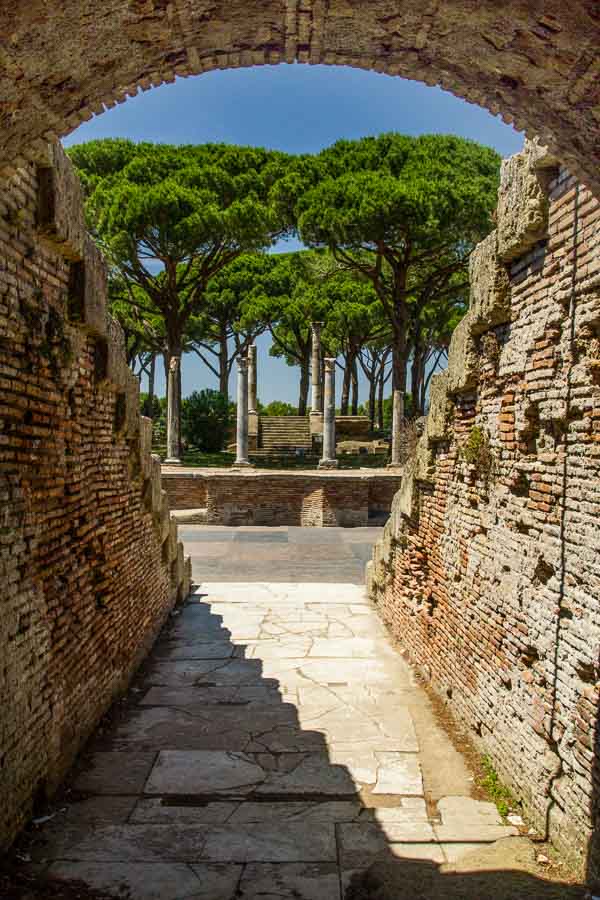
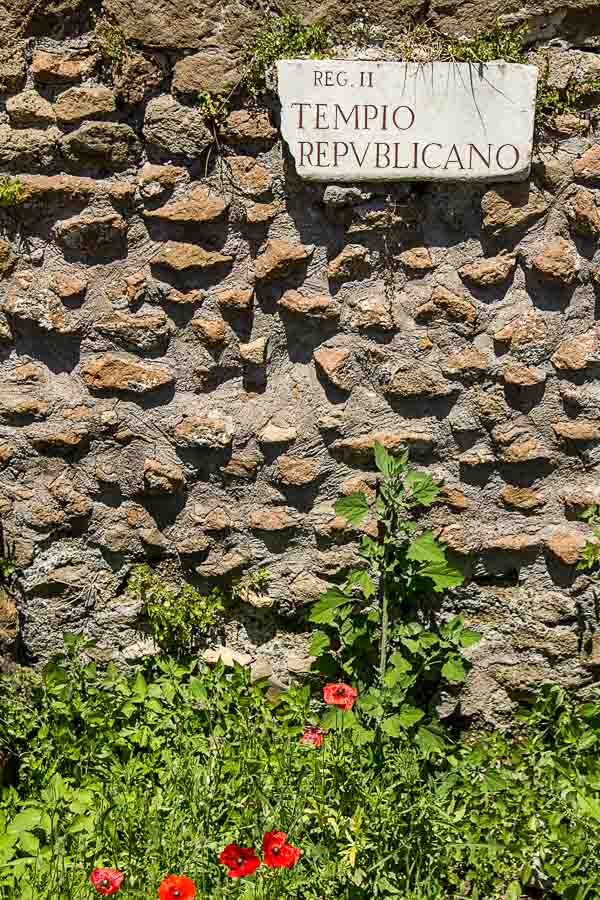
Why I prefer Ostia Antica to Pompeii
Both Pompeii and Ostia Antica are fascinating archaeological sites.
Each has intact public buildings, a theatre and a bathhouse. Pompeii has many more houses to see than Ostia Antica, which has mainly public buildings. Thanks to its dramatic backstory, Pompeii is better preserved.
However, if I was pushed to choose between the two, I would plump for Ostia Antica.
Ostia’s ruins, providing a remarkable insight into the domestic and commercial life of the Roman Empire, are set in a beautiful park of stately cypresses and umbrella pines.
I loved the slower pace and fewer crowds of Ostia Antica. Whilst you are unlikely to have the site to yourself, it is not so well established on the tourist radar. There’s a lot to be said about being able to walk along the streets of an ancient Roman town in near solitude.
Accessibility is a key factor too. To preserve the ruins, Pompeii is thoroughly fenced or roped-off to stop you from entering some buildings. Exploration of the site is via a prescribed route.
Exploration of Ostia Antica, on the other hand, is much more laissez-faire. Getting from A to B is more random but allows you to “discover” something else to explore further.
Having said this, if you are visiting Naples and Southern Italy, I would urge you to include Pompeii on your itinerary.
But if you are staying in Rome, don’t go all the way to Pompeii to see Roman life. Instead, choose Ostia Antica. You won’t regret it.
LIKE THIS ARTICLE? THEN TAKE A LOOK AT THESE
- Best Solo Travel Destinations in Italy
- 35+ Famous Landmarks in Rome, Italy That You Will Love
- How to Order Coffee in Italy Like a Local!
- 40 Best Movies Set in Italy

About Bridget
Bridget Coleman has been a passionate traveller for more than 30 years. She has visited 70+ countries, most as a solo traveller.
Articles on this site reflect her first-hand experiences.
To get in touch, email her at hello@theflashpacker.net or follow her on social media.

Excellent article!
Thank you! You can probably tell that I love Ostia Antica :)
I’ve been to both places with high school students many times. I absolutely agree with you that Ostia provides the same excitement and experience without the travel exhaustion and expense. I’m delighted that you write such a fine article on a wonderful historical gem.
Hello! Thank you for these kind words and for taking the time to comment. You can tell that I love Ostia Antica.Lucky you for having the opportunity to visit it many times over.